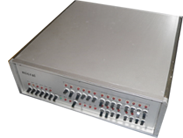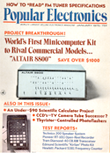The Single Greatest Year in Tech History, Part One: The 1970s
We're going to identify the one year that made the biggest difference...and we need your help to do the job.By Harry McCracken | Monday, December 1, 2008 at 11:34 am
With movies, it’s unquestionably 1939, the fabled year that saw the release of Gone With the Wind, The Wizard of Oz, Stagecoach, Wuthering Heights, Dark Victory, and Goodbye Mr. Chips. With baseball, there are multiple contenders, including 1924, 1949, and 1998…but I’m a Red Sox fan, so let’s just say it–it was 2004. Rock music? Maybe 1967, the year of The Beatles’ Sgt. Pepper, Jimi Hendrix’s Are You Experienced?, The Doors’ The Doors, The Who’s The Who Sell Out, and Aretha’s I Never Loved a Man the Way I Love You.
But what was the greatest year in technology history–the one that saw the highest number of significant products appear and/or other important events transpire? As far as I know, nobody has ever asked that question, let alone attempted to answer it. Will you join me in trying to figure it out?
In the coming days, Technologizer will recap significant moments, year by year and decade by decade, and give you the chance to vote on the years that made the biggest difference. For reasons of practicality, we’re beginning all this with 1970–we’re pretty sure that the greatest year, whatever it may be, happened in the past 39 years. (If you want to advocate for an earlier year, we’ll give you the chance to do so at some point via write-in votes; anyone know for sure what year the wheel was invented?) We’re also defining technology to cover personal technology relating to information and entertainment: PCs, Web stuff, TVs, MP3s, phones, and GPS, but not airplanes, cars, or clones. Eventually, we’ll winnow down the contenders and determine a winner.
And nope, there’s no hidden agenda here: I can think of half a dozen years that are contenders, but I’ll be as surprised as anyone else when we determine what the Single Greatest Year in Tech History is. Which we’ll do before the end of 2008.
So without any further ado, return with us now to the decade that gave us Apple, Microsoft, PCs, networking, word processors, spreadsheets, gaming consoles, and a whole lot more…
1970
Got RAM? Sure you do–gigabytes and gigabytes of it, maybe. And it’s all the modern offspring of Intel’s 1103 chip, the first commercially-available dynamic RAM, which the company unveiled in 1970. It stored a whopping 128 bytes of data. Which, back in those days, was enough memory to get excited over.
1971
 In 1971, the concept of personal computing was still years away–but it was a big year for the building blocks would eventually make personal computing possible. For one thing, one of the machines which would eventually be among several that would jockey for the honor of having been the world’s first personal computer was released–John Blanenbaker’s Kenbak-1. It cost $750 and came with 256 bytes of memory. It was also the year that Intel shipped the first microprocessor, the 4040; it powered calculators and was the predecessor of the 8080, the first real microcomputer CPU. Then there was the floppy disk, invented in 1971 by IBM and available at first only in jumbo-sized 8-inch form. And while e-mail existed before 1971, this was the year that Ray Tomlinson wrote a program to let messages be sent between computers on the ARPANet, which is what the Internet was known as back then. (Tomlinson needed a way to identify what computer a particular e-mail account resided at. We use his solution–the @ sign–each time we send an e-mail to this day.)
In 1971, the concept of personal computing was still years away–but it was a big year for the building blocks would eventually make personal computing possible. For one thing, one of the machines which would eventually be among several that would jockey for the honor of having been the world’s first personal computer was released–John Blanenbaker’s Kenbak-1. It cost $750 and came with 256 bytes of memory. It was also the year that Intel shipped the first microprocessor, the 4040; it powered calculators and was the predecessor of the 8080, the first real microcomputer CPU. Then there was the floppy disk, invented in 1971 by IBM and available at first only in jumbo-sized 8-inch form. And while e-mail existed before 1971, this was the year that Ray Tomlinson wrote a program to let messages be sent between computers on the ARPANet, which is what the Internet was known as back then. (Tomlinson needed a way to identify what computer a particular e-mail account resided at. We use his solution–the @ sign–each time we send an e-mail to this day.)
1972
If you’d heard of Hewlett-Packard back in 1972, chances were good it was because of the company’s calculators. The HP 35, introduced in 1972 for $395, was the company’s first pocket model–a little miracle in an age when the slide rule still…ruled, and the predecessor of pocket calculators which HP offers to this day. 1972 was also the year that Atari released Pong. It wasn’t the first video game (or even the first tennis one, or the first Atari one). But by just about any measure, it was the video game that introduced America to videogames. Also new in 1972, and historically important if far less pervasive than Pong was Magnavox’s Odyssey, the first video game console. And then there was Polaroid’s SX-70, the first truly hassle-free instant camera; it made the cover of both LIFE and TIME when it was released, and I for one would still find it to be kind of amazing if it were released today.
1973
 The ubiquitous Network connection known as Ethernet was one of a gazillion essential aspects of modern computing that emerged from Xerox’s PARC laboratories. Co-invented by Bob Metcalfe and David Boggs, it was proposed in May 1973 and first worked in November of that year. PARC also designed the Alto, the legendary workstation that had a slick graphical user interface, a mouse, and other advanced features in an age when you still programmed many computers by flipping switches. (The Alto was never available commercially, but the rest of the industry spent the next twenty years ripping off Xerox’s brainstorms.) Also new in ’73: The Micral-N (image at right), another contender for the title of first personal computer. That distinction remains subject to debate, but it does seem to have been the first computer that was based on a microprocessor (Intel’s 8008) and which didn’t require buyers to put everything together themselves. (Which surely counts for something–quite a lot, actually.)
The ubiquitous Network connection known as Ethernet was one of a gazillion essential aspects of modern computing that emerged from Xerox’s PARC laboratories. Co-invented by Bob Metcalfe and David Boggs, it was proposed in May 1973 and first worked in November of that year. PARC also designed the Alto, the legendary workstation that had a slick graphical user interface, a mouse, and other advanced features in an age when you still programmed many computers by flipping switches. (The Alto was never available commercially, but the rest of the industry spent the next twenty years ripping off Xerox’s brainstorms.) Also new in ’73: The Micral-N (image at right), another contender for the title of first personal computer. That distinction remains subject to debate, but it does seem to have been the first computer that was based on a microprocessor (Intel’s 8008) and which didn’t require buyers to put everything together themselves. (Which surely counts for something–quite a lot, actually.)
1974

Intel’s 8080–the first microprocessor that was powerful enough to make the idea of a truly sophisticated microcomputer plausible–shipped in April. Shortly before Christmas, Popular Electronics published a cover story on MITS’ Altair 8800, a microcomputer based on the 8080; the Altair didn’t actually ship until 1975, but it was by any definition the first truly popular PC. This was also the year that Gary Kildall completed work on a quixotic personal project called CP/M–a microcomputer operating system that dominated personal computing in the late 1970s and served as obvious inspiration for Microsoft’s MS-DOS.
1 2 NEXT PAGE»
8 Comments
Read more:














December 1st, 2008 at 12:25 pm
WHA??? No mention of WANG???
December 1st, 2008 at 2:30 pm
Impossible question. It’s like asking me what was my greatest year. My daughter Erica was born in 1975, and Amy was born in 1979. I think some other great things happen before or in between.
Bill
December 2nd, 2008 at 8:57 am
In 1973, Ethernet, TCP/IP, AND the cellphone were invented.
December 15th, 2008 at 1:22 am
Personally I think the year UNIX came about was the greatest year in technology, the years following that were only built upon UNIX itself. And when the Amiga came, that was a revolution. But really I don’t think it’s fair to say that there can be one favourite year, or even decade of computing history; every year new technology comes out and things will improve; in a decade or so we might all have new favourites. Past, present and hopefully future will be my favourite decades of technology. What we have now wouldn’t be around if our predecessors hadn’t thought of it, and our future depends on what we do now.
December 22nd, 2008 at 9:47 am
Find it hard to believe that there is no mention of the early Heath (later Heath/Zenith) machines that started coming out in the mid-70’s. Their first ones were the H-8 and the H-11 and were followed by a great machine the H-79 and then the H-100 which was a dual processor machine that would run HDOS (Heath Disk Operating System, an OEM MSDOS), CP/M (8-bit) and MP/M (16 bit.) They had a great idea, buy an H100 and run your present CP/M software on it then when you changed down the road to a DOS based system, you could use the same machine! Lack of marketing on the part of Heath/Zenith killed that line though.
December 22nd, 2008 at 10:22 am
Wow!! You skipped over core memory? 1st comp I worked on was the PDP-1 by Digital Equipment Corp., and had 16K of core memory… and it was randomly accessed… this was in 1961.
January 3rd, 2009 at 10:44 pm
The 70’s brought us Disco, and heavy metal music that helped loosen up Bill Gates and Steve Jobs so they could both move on to conquer the world with the Mac and PC.
Where would home computers be without the entertaining, gaming, music and creative artistic design aspect.
I say 1976 was the year that it all started coming together
January 3rd, 2009 at 11:22 pm
moving fast forward through the high tech time machine I notice by September of 2001 computers, software, the Internet and technology in general were speeding up so fast that by the time you went to CircuitCity and bought a brandnew PC with all the fixings for about $4,500. you’d have the latest, greatest personal machine on the market, for about a week.
The sure enough a new one would be released making yours a little outdated, “Oh Rats”
But after 9/11 everything kind of SLOWED DOWN AND FROZE UP for a while. Yeah, you could get whistles and bells, but the actual hardware seemed to slow down, Software had problems and it cost more and more to fix the errors. Not just Windows but Macs had problems to.
After 9/11 technology went into the darkside for a while, maybe people were just too scared that the general population was getting too many powerful tools that UNLOCK SECURITY DOORS of all sorts and send mass viruses all over the place, or maybe too many lawyers got in the act and got new laws passed to protect certain property right ownerships of musicians, etc. But it slowed everything down for the consuer.
Anyone remember Napster? how about “KAZAA” I confess I downloaded a few songs from KAZAA via sharing it with others, but they went over board and made some deals so now you have to pay them big bucks for their songs, but why not use ITunes if your gonna go that route?
Think about it folks. A billion people from around the world with cellphones, YouTube accounts and the ability to exchange all those ideas in a moments notice.
You’d think that a group meeting with a billion people who put their thoughts together in a constructive manner just might be able to come up with some brilliant sollutions to some of the problems our generation is facing right now.
It may cost a few hundred million or more to get it all set up and connected, but we just might be at the verge of mutual self destruction and it’s when we’re at out worse that it brings out the best in people.
Let’s get crackin, you’d be suprised what a billion people can do IF we can organize the communications so it doesn’t get too much of an unorganized confused mess of people screaming at each other for war issues, economy issues, global warming issues etc.
just e-mail me if you have any suggestions but make it short and down to the point QUICKLY, REMEMBER i MAY HAVE TO SIFT THROUGH A BILLION MESSAGES SO DON’T TRY TO SPAM ME, just get to the point quickly steve@nttgold.com